In addition to the propeller and cup anemometers, there are other types that use different measurement methods, principles and ranges of wind speed. Figure 1 shows some examples, including the wind pressure anemometer and the sonic anemometer. This article gives an outline of the measurement principles and features of these devices.
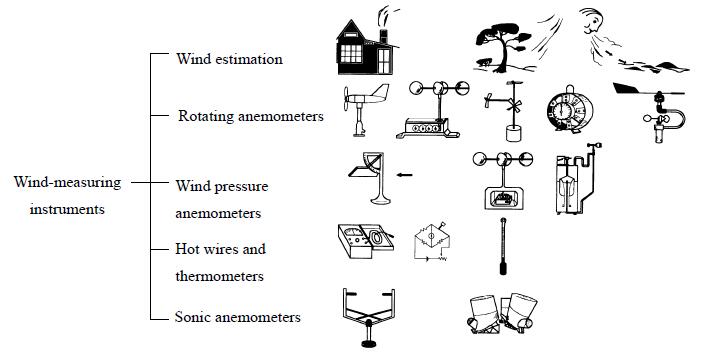
Method Using Wind Pressure Measurement
Dines Anemographs
A Dines anemograph measures wind pressure to ascertain instantaneous wind speed. A single-plate vane is fixed to a pitot tube to allow its sensor to face the wind directly at all times as shown in Figure 2. There is an inlet hole B at the end of the pitot tube to measure dynamic pressure and a row of small holes A along the periphery of the tube at equal intervals to measure static pressure. The pressure values at B (dynamic pressure) and A (static pressure) caused by wind are induced through two pipes C1 and C2 into the inside and outside of a uniquely shaped float in a column of water. The upward and downward movement of the float is recorded on a clock-driven drum to represent instantaneous wind speeds.
This instrument has poor response to very weak wind conditions and rapid wind fluctuations. Additionally, because the difference between dynamic and static pressure is affected by air density, it is necessary to compensate changes in temperature. It is also necessary to prevent the water from freezing and exclude vibration to ensure that the float functions as intended in the water.
Measurement range: 0 to 60 m/s
Measurement accuracy: ±0.5 m/s
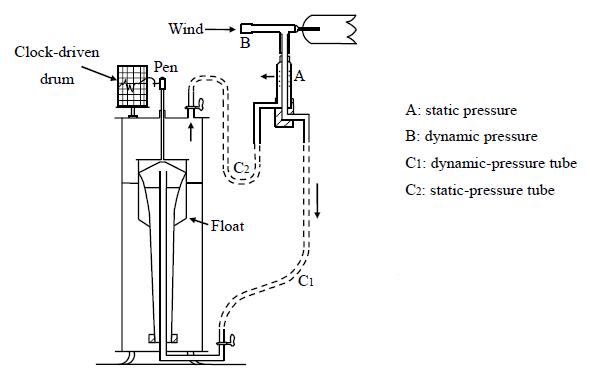
Method Using Heat Radiation
Hot-wire Anemometers/Thermistor Anemometers
A hot-wire anemometer measures wind speed based on the theory that when a hot metal wire is exposed to wind and then cooled, its electrical resistance changes (Figure 3). Platinum wire is generally the type used for this purpose. As these anemometers have a small sensor part, they are suitable for wind speed measurement in confined environments. This type of anemometer has a bridge circuit with a hot wire (the sensor) fitted on one side of the bridge. As wind blows against it, its temperature decreases and its electrical resistance changes; this creates an imbalance in the bridge and causes an electrical current to flow. The relationship between the current and the wind speed is predefined, and the current is converted to a wind speed value.
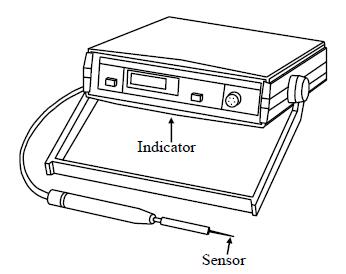
Another type of hot-wire anemometer that uses a thermistor device rather than a platinum wire has recently been introduced. The advantage of this new type is that it features superior sensitivity and response characteristics even in weak-wind conditions. However, if rain, snow or mist touch the sensor, large measurement errors may arise; it is therefore not suitable for outdoor use and cannot be used as a meteorological measuring instrument.
Measurement range: 0 to 1 m/s, 0 to 10 m/s, 0 to 50 m/s and various other ranges
Measurement accuracy: ±2% to ±3% in each respective measurement range
Method Using Sound Propagation
Sonic Anemometers
Ultrasonic waves of more than 20 kHz that are inaudible to humans propagate at a speed of about 340 m/s in wind-free conditions. Sonic speed changes slightly in wind; sound waves propagate at a higher (lower) speed in the same (opposite) direction as its movement. A sonic anemometer leverages this relationship between wind and sound-wave propagation (Figure 4).
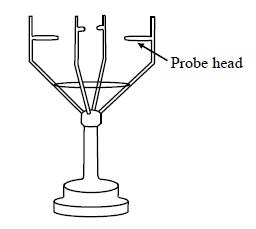
A sonic anemometer has two pairs of sonic transmitting/receiving devices (heads) fixed facing each other across a specified span. Ultrasonic wave pulse signals are repeatedly emitted alternately from each pair of heads at certain time intervals. The propagation times of the ultrasonic pulses in opposite directions are measured; the wind speed is calculated in each direction, and the wind direction and speed are derived through vector synthesis. As the speed of sound in air depends on the temperature, measuring techniques have been developed to minimize this influence.
Because sonic anemometers have no moving parts to be actuated by wind force, the concept of a starting threshold speed is not applicable; such devices provide wind speed measurement from calm conditions upward. They also respond much more quickly to changes in wind direction and speed than rotating anemometers.
Measurement range: 0 to 60 m/s
Measurement accuracy: ±0.2 m/s
SODAR (Sound Detection and Ranging)
The pitch of an ambulance siren or a train sounds higher when approaching the listener than when moving away from him or her. The phenomenon whereby sounds appear to have a higher or lower pitch than their actual frequency is known as the Doppler effect. A SODAR device uses sound-wave deviation to measure upper-air wind speeds (Figure 5). It emits audible sounds (in a range from 1 to 6 kHz) from its transmitter in three directions (vertical, obliquely upward in a north-south direction and obliquely upward in an east-west direction) and monitors their return as they are scattered by air-mass density fluctuations. By detecting the difference between the frequency of the emitted sound waves and that of the ones that return (known as Doppler shift), the average movement of an air mass (i.e., the three directional components of wind) can be measured.
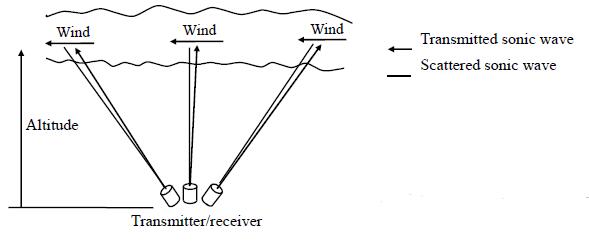
This instrument is advantageous in that it can continuously measure winds at altitudes of 500 to 600 meters.
